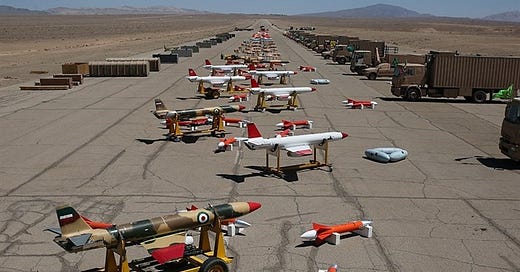Can Iran and/or its proxies deploy “dirty bombs” with suicide drones?
The regime ruling Iran has long been recognized as the world’s leading state sponsor of terrorism. Tehran has been investing heavily on its fleet of drones as new weapons to compensate for its aging air force. Considering its controversial nuclear program and world powers pledging to stop the mullahs from obtaining nuclear weapons, one dangerous option before Iran is using suicide drones to conduct “dirty bomb” attacks on a variety of civilian and military targets.
What is a dirty bomb?
“A dirty bomb or radiological dispersal device is a speculative radiological weapon that combines radioactive material with conventional explosives. The purpose of the weapon is to contaminate the area around the dispersal agent/conventional explosion with radioactive material, serving primarily as an area denial device against civilians. It is, however, not to be confused with a nuclear explosion, such as a fission bomb, which by releasing nuclear energy produces blast effects far in excess of what is achievable by the use of conventional explosives.”
Also described as an “improvised nuclear device,” dirty bombs have been in discussion for some time now. Back in 2013, a study by the General Accountability Office concluded that U.S. cities are not ready for nuclear terrorism.
The term nuclear terrorism is what is most important here in our discussion as we review the threats posed by Iran, knowing how this regime provides at least hundreds of millions of dollars each year to a conglomerate of active proxy groups checkered across the Middle East. If U.S. cities were not prepared for nuclear terrorism, rest assured many U.S. bases and U.S. allies in the region are not either.
Can Iran deploy dirty bombs with its drones? One expert has told me it is quite possible.
“A dirty bomb would be a combination of explosives and radioactive dust/pellets that would be dispersed by the explosives. The only question is how much of a payload an individual drone could carry. But then several would be able to cover a fairly wide area,” says Capt. Stu Cvrk, U.S. Navy (Ret), an expert in chemical-biological attack responses.
The Iranian opposition coalition National Council of Resistance of Iran (NCRI) held a press conference in Washington, DC, on October 6 providing new information on Iran’s massive drone production and distribution program.

What makes this topic even more troubling is the fact that Iran has a long history of providing its drones and drone production technology to its long slate of proxy terrorists throughout the Middle East.
The Jamestown Foundation – November 17, 2017
Hezbollah’s Drone Program Sets Precedents for Non-State Actors
“Hezbollah’s first successful drone deployment took place in November of 2004, when the group deployed an Iranian made Mirsad-1 military-grade surveillance drone into Israeli airspace and surveilled Nabariva, a city in northern Israel, for about 20 minutes.”
The Jerusalem Post – May 15, 2021
Iran’s hand seen in Hamas drone threat against Israel – analysis
“Why do drone threats matter? Because drones can carry warheads and also move slowly and may be able to maneuver. Most of the Iranian-style drones, which are called ‘loitering munitions’ or ‘kamikaze’ drones, are the kind that can be programmed to fly to a certain destination and then sent on their way.”

Iran displays long-range combat drone, names it "Gaza"
“Iran has a large missile and drone program, regarding such weapons as an important deterrent and retaliatory force against the United States and other adversaries in the event of war.
“The Revolutionary Guards said the new drone was capable of flying for 35 hours and carrying 13 bombs and 500 kg (1,100 lbs) of electronics equipment, the state news agency IRNA reported.”
Iranian-backed Houthi rebels in Yemen ramp up drone, missile attacks on Saudi Arabia
“Iran-backed Houthi forces are launching more and more armed drones and missiles against Saudi Arabia… The scale and reach of the Houthi attacks illustrates how the rebels have progressed as a fighting force since the start of the Yemen war in 2015, and just how much they have benefited from Iranian arms and advice, according to regional analysts and U.N. experts.
“A January U.N. report said there were growing indications that Iran was providing arms and weapons components to the Houthi rebels via smuggling routes at sea.
"An increasing body of evidence suggests that individuals or entities in the Islamic Republic of Iran supply significant volumes of weapons and components to the Houthis," the U.N. panel of experts report said.
Iran used a drone launched from Syria’s T-4 base in Syria to attack Israel in 2018. It managed to enter Israeli airspace before being eventually shot down by a helicopter. There are also reports that Iran advised Hezbollah to dispatch what Israel described a “killer drone” team to an area near the Golan Heights in 2019.
Iran also deployed drones to attack Saudi Arabia’s Abqaiq oil-processing facilities in September 2019.

The New York Times – June 4, 2021
Iran’s Proxies in Iraq Threaten U.S. With More Sophisticated Weapons
Iran-backed militias in Iraq are suspected of carrying out recent drone strikes on sensitive American targets in Iraq, evading U.S. defenses.
“At least three times in the past two months, those militias have used small, explosive-laden drones that divebomb and crash into their targets in late-night attacks on Iraqi bases — including those used by the C.I.A. and U.S. Special Operations units, according to American officials.”
The simplicity of deploying drones, launched from a ground-fixed rail, installed on a truck, or even a boat, have made it all the more conventional for Iran. The regime has established many drone units in its own military and provided these weapons and/or technology to its proxies. Being easily produced and assembly lines not needing sophisticated technology, Iran can transfer money from new sanctions relief — thanks to the Biden administration’s ongoing appeasement policies — to further develop and advance its drone fleet.

Reports in the past have traced gyroscope technology used for guidance in different drones back to Iran, further indicating the regime’s transfer of these arms to its proxies in Yemen, Iraq, Syria. They have even been found in Sudan, Afghanistan and Venezuela, according to numerous reports.
As previously mentioned, Iran has most likely reached the conclusion that world powers will not allow it to obtain nuclear weapons.
“I think that Iran, to this day, is not even close to acquiring a nuclear weapon... This is due to longstanding efforts by some forces in the world,” said former Mossad chief Yossi Cohen said at The Jerusalem Post Diplomatic Conference on Tuesday, October 12.
However, Iran may consider reaching the nuclear threshold of establishing the very ability to obtain nuclear weapons at its will or producing numerous “dirty bombs” to be deployed with its drone fleet could provide a major upper hand for Tehran in any negotiations. Something similar to North Korea that has obtained nuclear weapons capability and its threat hangs as a shadow over U.S.’ allies Japan and South Korea.
As a result, the international community, especially the U.S. and Europe, need to adopt firm policies aiming to shelve Iran’s nuclear and drone programs. This is crucial in any possible talks, although indirect, between the U.S. and Iran over the prospects of returning to the 2015 Iran nuclear deal. Otherwise, money from eventual sanctions relief will fund its nuclear/drone programs, thus increasing the already escalating threats posed by Tehran’s regime.








